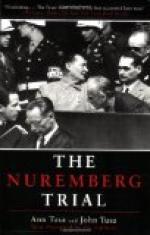|
This section contains 397 words (approx. 2 pages at 300 words per page) |

|
The war in Europe ended on May 8, 1945, when Germany surrendered. In less than six months the Allies had decided to hold war crimes trials. A dedicated staff chose defendants, established procedures, gathered and analyzed thousands of pages of documentary evidence, and renovated the building in Nuremberg in which the most prominent trial would be held. This was not an easy accomplishment, especially since many other things were going on simultaneously.
For one thing, World War II was not over. Fighting against Japan continued in the Pacific throughout the summer and ended only after the atomic bombs were dropped and the formal surrender was signed on September 2. In Europe, the Allies were involved in a variety of activities, including creating displaced-persons camps for the thousands of refugees who survived the war but could not return to their homes, rebuilding the shattered economies and infrastructure of...
|
This section contains 397 words (approx. 2 pages at 300 words per page) |

|




